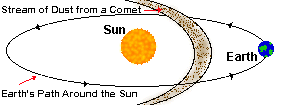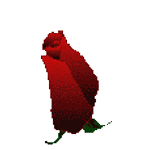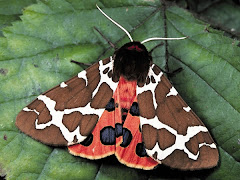Voor Nederlandse vertaling verder naar beneden scrollen!
A "falling star" or a "shooting star" has nothing at all
to do with a star! These amazing streaks of light you
can sometimes see in the night sky are caused by
tiny bits of dust and rock called meteoroids
falling into the Earth's atmosphere and burning up.
The short-lived trail of light the burning meteoroid
produces is called a meteor. Meteors are commonly
called falling stars or shooting stars.
If any part of the meteoroid survives burning up and
actually hits the Earth, that remaining bit is
then called a meteorite.

At certain times of year, you are likely to see a
great number of meteors in the night sky.
These events are called meteor showers and they occur
when the Earth passes through the trail of debris left by
a comet as it orbits the Sun. These showers are given
names based on the constellation present in the sky
from which they appear to originate.
For example, the Leonid Meteor Shower, or Leonids,
appear to originate in the constellation Leo.
It is important to understand that the meteoroids
(and therefore the meteors) do not really originate
from the constellations or any of the stars in the constellations, however. They just seem to come from that part of
the sky because of the way the Earth encounters the
particles moving in the path of the comet's orbit.
Associating the shower name with the region of the sky they
seem to come from just helps astronomers know where to look!

The dust and rocks that cause meteor showers come
primarily from the Earth passing through the debris
stream left behind by a comet as it orbits the Sun.
Usually, the Earth's orbit and the comet's orbit are slightly
tilted relative to one another.
So the paths only intersect on one side!
~ INFO LINK ~
Een meteoor staat ook wel bekend als een
vallende ster, maar heeft niets met een ster te maken.
Het is een kortstondig
lichtspoor aan de hemel dat men ziet wanneer een
klein stofdeeltje (een meteoroïde) op ca. 100 km hoogte
met een enorme snelheid (tot tientallen km per seconde)
in de atmosfeer van de Aarde terecht komt.
De meteoroïde wordt door de atmosfeer afgeremd.
Door de enorme wrijvingskrachten die hierbij ontstaan
wordt het deeltje uiteengerukt tot losse moleculen en
"verdampt" het als het ware volledig.
Bij lichamen groter dan het gemiddelde atmosferische
vrije pad (10 cm tot verscheidene meters) wordt dit
zichtbare licht veroorzaakt door de hitte als gevolg
van ram pressure, en niet door wrijving, zoals
meestal aangenomen wordt. De wrijvingskrachten
doen bovendien ook de omringende lucht oplichten,
zoals een elektrische stroom het gas in een buislamp.
Er is dus een ionisatie van de omliggende luchtkolom.
Het lichtspoor begint te ontstaan en wekt soms de illusie
van een ster, die zich plotseling snel verplaatst.
Een deeltje ter grootte van een erwt geeft al een
bijzonder heldere lichtstreep. Een zeer helder lichtspoor
(helderder dan de planeet Venus) wordt ook wel
een vuurbol of bolide genoemd.
Meteoroïden vallen 24 uur per dag de atmosfeer binnen,
maar de lichteffecten zijn (behalve in zeer uitzonderlijke
gevallen) alleen 's nachts te zien, en met het
blote oog alleen als het heel donker is.
Meteoren kunnen afzonderlijk komen, maar ook in
zwermen of sterrenregens, bijvoorbeeld
de Leoniden of Perseïden.

Het zien van een vallende ster is volgens de folklore
aanleiding tot het doen van een wens.



































6 opmerkingen:
Lovely art and information!
Greeeeeaaaaat, Anna!!!!!
@ Aqutsiaq
thanks, I thought so too!
what teamwork hé?
Wonderful post Anna. I have wished upon many. ;)
hugs,
shell
Anna...Congratz!!
Great post, i love shooting stars, we often see them here over the hills x happy new year to you x x
Een reactie posten